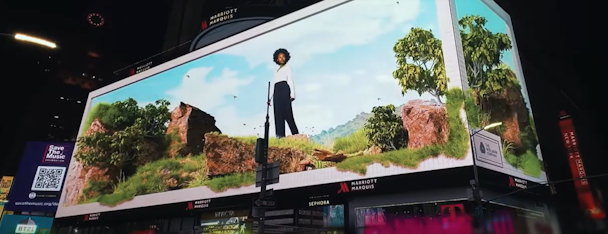‘Bold, bright and dizzying’: the future of 3D billboards
For our Predictions Deep Dive, creative agency 20Something’s Will Thacker muses on what the future of 3D billboards looks like and how advertisers can continue to surprise people.

20Something’s 3D billboard campaign for The Woolmark Company / 20something
Six years on since Coca-Cola first debuted the concept and we’ve already seen the good, the bad and the meh in the world of 3D out-of-home (OOH).
The last few years surfaced a bumper crop, from the voluptuous rendered bubbles of the Air Max to an avalanche of Poké Balls, not to mention all the cats (why so many cats?).
The power of the medium is its ability to transcend its own sizable screen and travel to our own small screens as we like and share the latest in larger-than-life animations.
Advertisement
The beauty of 3D OOH
I question how many people actually do stand on the exact pinpoint spot to see the “real” anamorphic, as opposed to the sanitized filmed version we pass around on LinkedIn. Another curious quirk of this medium is that an execution can run just once, for five seconds in the middle of the night, on a screen no one can see, and then be passed around the world for millions to enjoy. The magic of 3D is that, for the moment, we’ve rekindled the concept of “event” advertising.
One thing’s for sure, the development of the medium is unleashing a burst of creativity in what some people have termed the “phygital” space. As usual, luxury fashion brands are leading the charge but brands across the spectrum are becoming more comfortable with flexing their biceps in the space. We’re seeing more entertaining, narrative-led visual wonders emerge – like Louis Vuitton’s technicolor Yayoi Kusama, wearing a pumpkin and peering over the streets of Tokyo’s Shinjuku district.
But what’s next for 3D anamorphic billboard? For a medium that relies on shareability for its cost efficiency, how do we keep the outputs fresh and the eyeballs interested?
Advertisement
The answer lies in blowing up the format. Shake off the shackles of the word “poster” and reframe the opportunity. These spaces and ideas have the potential to stretch across experiential activation, immersive experiences, branded content, trial mechanics and personalization. Soon we will be able to step inside and “try on” digital assets before we buy them. And it won’t be long until the format is not just on the big screens of big cities but it will be on the train, on the street or on a trusty bus-stop six-sheet. Perhaps one day we will be able to get to a level of personalization where I see something different to you or perhaps you can interact with me through the medium.
The most successful attempts will continue to blur the lines between art, entertainment and advertising. The least successful will crowbar 3D elements into bland sales messages – choose your Subway sandwich, anyone? We would do well to remember that we’re not just interrupting people’s lives; thanks to 3D, we’re now also invading their space, so we need to make it worth their while.
Suggested newsletters for you
What the future holds
We’ll soon see brands start to extend beyond the 3D billboard. We’ll see it combined with augmented and virtual reality as well as physical special builds. We’re already seeing the intersection of these technologies in the gaming space with the likes of Mario Kart Live Action, a Nintendo Switch game that enables you to play Mario Kart through your own home by driving around a miniature cart with a camera that connects to your switch screen.
This should, with any hope, create more engaging branded experiences. Mobile-enabled AR could extend these experiences into wider locations – one day you could collect “screen experiences” and connect them to create a personalized piece of content or promotion. The connection between huge public screens and individual mobiles is ripe for creative application, for example, a large screen could start a narrative storyline of a game that people can follow in their own time on their mobile and continue to play individually.
Provided the councils and municipal powers keep up, interactivity could transform public places. Imagine taking control of Piccadilly Circus. Imagine making that a space in which you can play, compete, vote, create and build. To date, the examples have been crude. But the potential is huge.
Remote viewing and interactive elements open up the possibility of 3D OOH anywhere in the world. All we would need is a phone, browser and headset to potentially connect and communicate between screens across the world. The scope is so big, some might find it overwhelming but at 3DSomething, we always err on the side of excitement.
The future is looking bright, bold and maybe even a little dizzying. Moore’s law is well underway, and rapidly rendering the OOH of yesteryear obsolete. It’s a brave new world out there. But like any medium, without razor-sharp thinking, breathtaking execution and an eye for craft, the concept can quickly go from “wow” to “meh” and no amount of cute 3D cats will rescue it.
As always, the tools change, but the job remains the same.
For more takes on the year ahead, visit our Creativity Predictions hub. Will Thacker is co-founder of creative agency 20Something.
